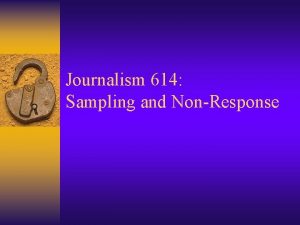Sampling of Content Analysis Types of sampling I










- Slides: 10

Sampling of Content Analysis

Types of sampling I. Probability A. Random: each unit has an equal chance of selection Example: Content analysis of election coverage in 10 Chinese newspapers. Randomly select a date and a newspaper. All newspapers and all dates have an opportunity to be included

Types of sampling I. Probability A. Random: each unit has an equal chance of selection Pro: Highest generalizability Known amount of error Easiest to justify: all things considered, the strongest method

Types of sampling I. Probability A. Random: each unit has an equal chance of selection Con: How do you get your sample? Is there a list? Costly: Time, materials, etc.

Types of sampling I. Probability B. Systematic: select every "nth" subject Example: News coverage of Presidential Election in the U. S. . Select a random starting point and select every 5 th date. If there’s 50 days, that would mean 10 stories would be included

Types of sampling I. Probability B. Systematic: select every "nth" subject Pro: Easier than random, because you don’t have to jump around to find the next case (No. 280, then No. 160, then No. 870, etc. ). All cases still have an opportunity to be included. Works great when you have a list.

Types of sampling I. Probability B. Systematic: select every "nth" subject Con: Still time consuming, since you have to record from a list (don’t have to do that with random digit dialing). Have to make sure that the “Nth” number you use isn’t somehow biasing the selection of cases (don’t do every 7 th date, for example).

Types of sampling I. Probability C. Stratified: select random sample from subgroups Example: Content analysis of election coverage in the U. S. : select an equal number of stories from Sunday, Monday, Tuesday, etc.

Types of sampling I. Probability C. Stratified: select random sample from subgroups Pro: Avoids possible problems with overselection of certain groups. Very generalizable, since you have equal numbers of cases on whatever variable you use to group your sample on.

Types of sampling I. Probability C. Stratified: select random sample from subgroups Con: Difficult to do unless you have a list with a breakdown on your grouping variable. Not purely random, so difficult to justify using the data for any other comparisons
 Content analysis sampling
Content analysis sampling What is esp
What is esp Dynamic content vs static content
Dynamic content vs static content Content analysis and discourse analysis
Content analysis and discourse analysis Job content analysis
Job content analysis Data quality is always a concern with secondary data
Data quality is always a concern with secondary data Sampling method in research
Sampling method in research Multistage sampling example
Multistage sampling example Stratified sampling example
Stratified sampling example Perbedaan time sampling dan event sampling
Perbedaan time sampling dan event sampling Stratified sampling vs cluster sampling
Stratified sampling vs cluster sampling


















